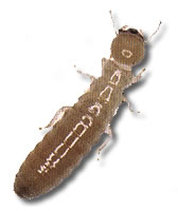Drywood Termites

Drywood and subterranean termites are the most destructive pests of wood, causing more than $1.7 billion in damages and cost of control each year in the U.S. alone. Generally, the first indirect sign of infestation is fecal pellets or the presence of alates on windowsills or near lights. Alates are the winged form of a termite, also commonly called a swarmer. If they are found inside a home with closed windows and doors, this can be an indication of infestation within the structure. Another indication is the presence of discarded wings near emergence sites, on windowsills, or caught up in cobwebs. However, the presence of alates outdoors is a natural phenomenon and is not a direct sign that your home is infested with termites.
It is a common misconception that size of the worker will indicate whether the termite is a drywood or subterranean. While many drywood species have larger workers than do subterranean termites, other drywood species have much smaller workers. Soldiers of drywood termites will be larger than the workers, with brownish heads and large, toothed mandibles.
Fecal pellets are distinctive and used for identification of drywood termite infestation. Drywood fecal pellets are dry, smooth, hard, powderlylooking, elongated and less than 1/25 inch long. Typically the pellets are a light tan in color with some black ones mixed in. They have rounded ends and six flattened or concavely depressed sides with ridges at angles between the six surfaces. The characteristic shape results when the termite exerts pressure on the fecal material to extract and conserve moisture in its hindgut. Since these termites live within their food, they must find ways to remove waste from the colonized area. These termites make small holes, kickholes, to kick out fecal pellets (frass). Piles of the pellets usually accumulate under these openings.
It is a common misconception that size of the worker will indicate whether the termite is a drywood or subterranean. While many drywood species have larger workers than do subterranean termites, other drywood species have much smaller workers. Soldiers of drywood termites will be larger than the workers, with brownish heads and large, toothed mandibles.
Fecal pellets are distinctive and used for identification of drywood termite infestation. Drywood fecal pellets are dry, smooth, hard, powderlylooking, elongated and less than 1/25 inch long. Typically the pellets are a light tan in color with some black ones mixed in. They have rounded ends and six flattened or concavely depressed sides with ridges at angles between the six surfaces. The characteristic shape results when the termite exerts pressure on the fecal material to extract and conserve moisture in its hindgut. Since these termites live within their food, they must find ways to remove waste from the colonized area. These termites make small holes, kickholes, to kick out fecal pellets (frass). Piles of the pellets usually accumulate under these openings.
